
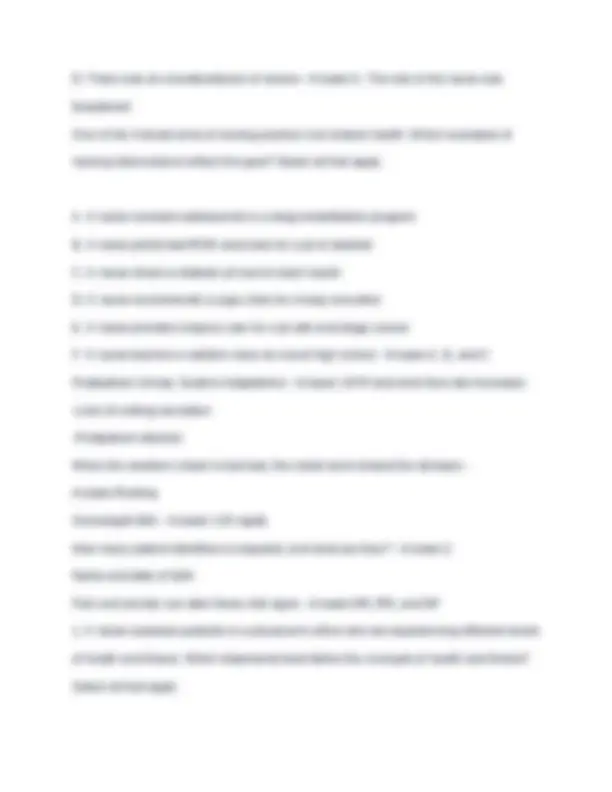
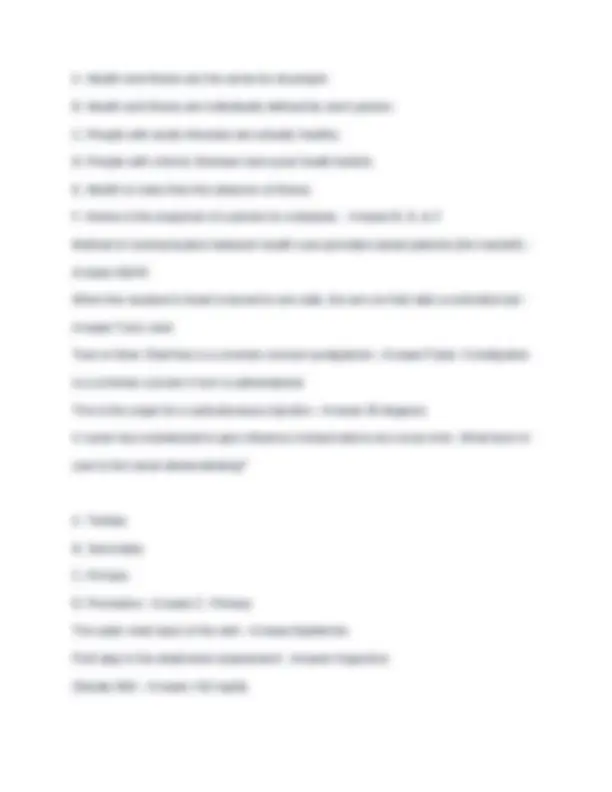
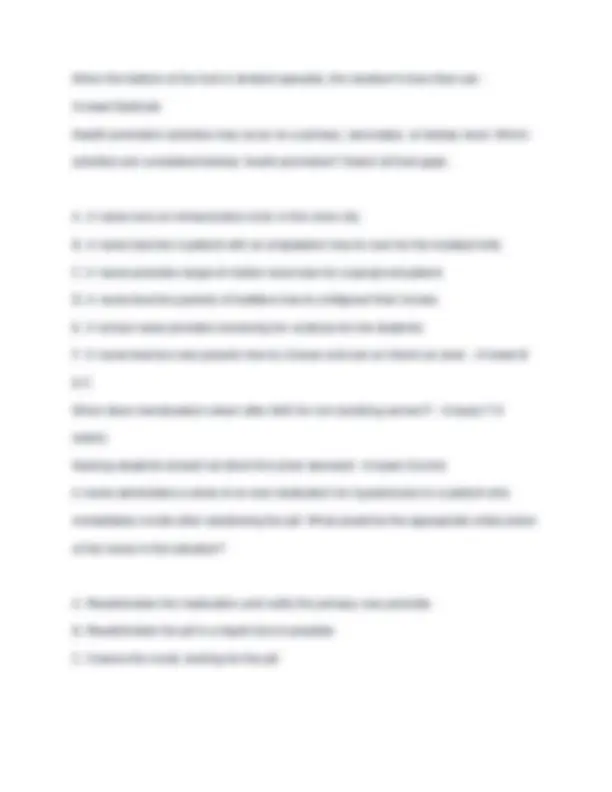
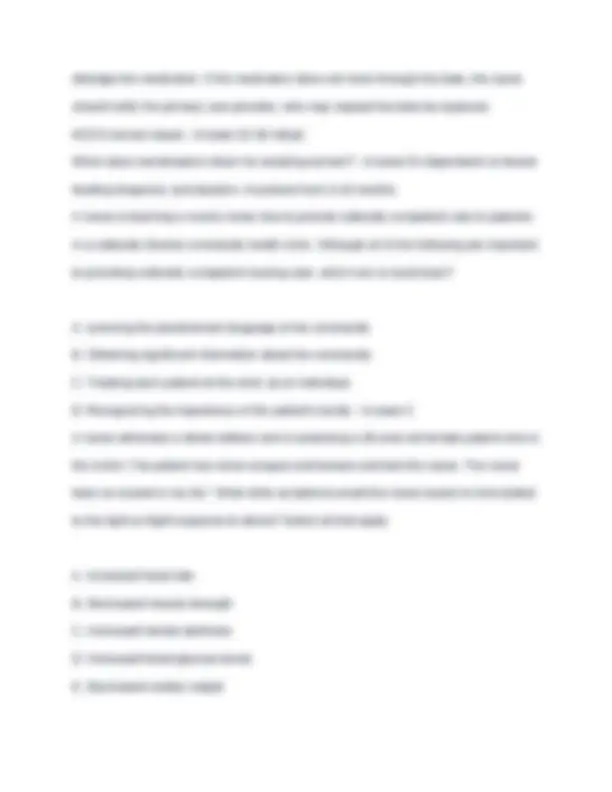
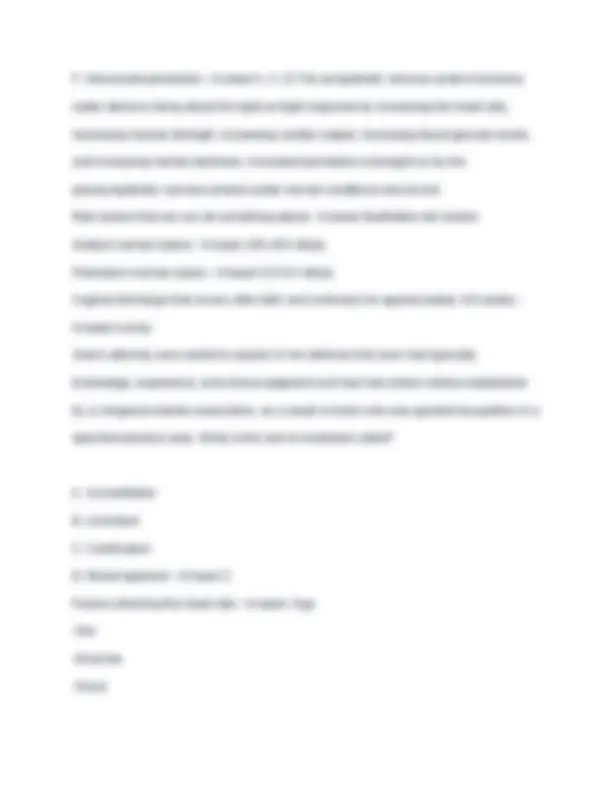
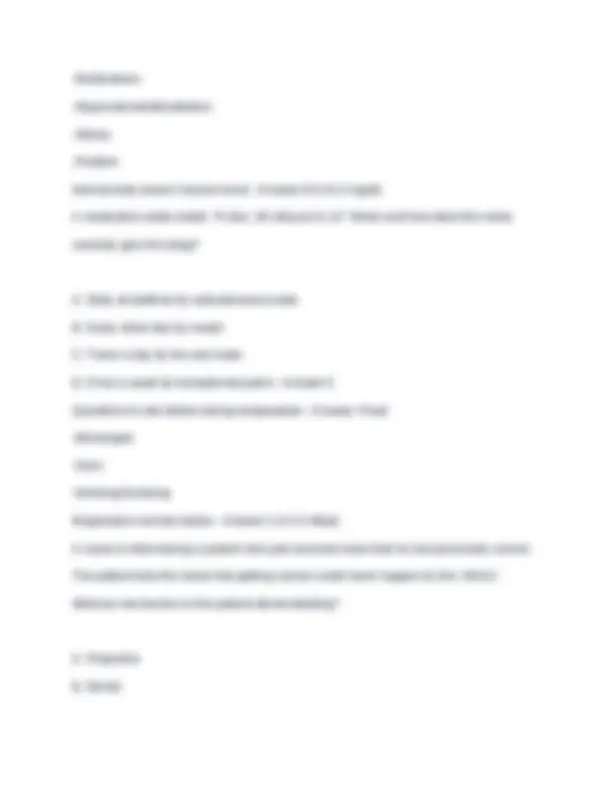
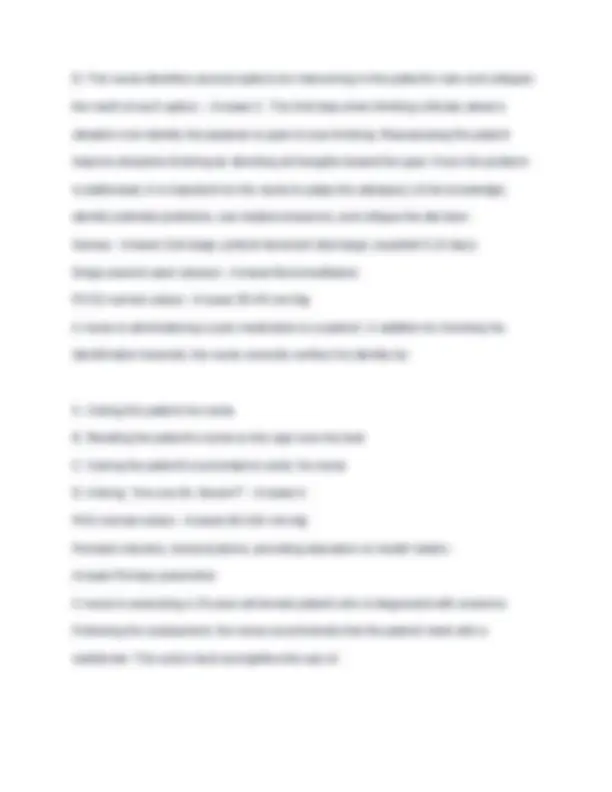
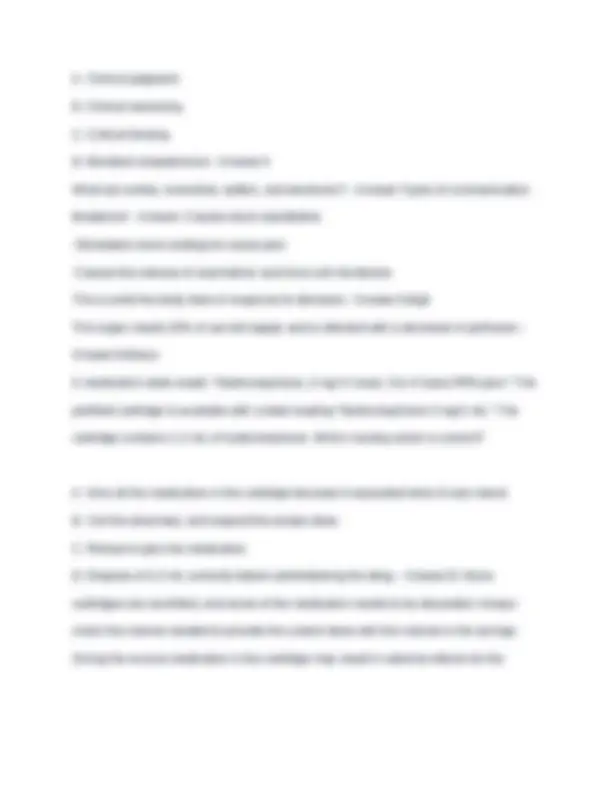
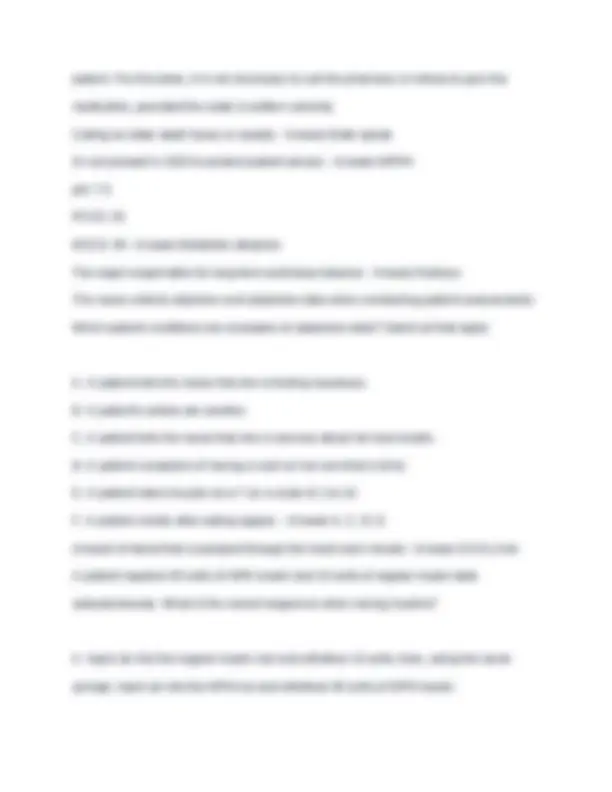
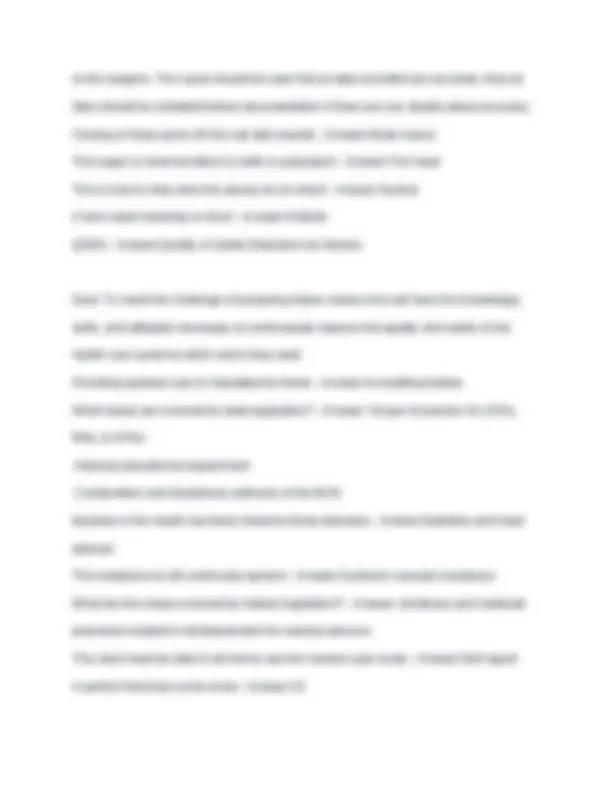
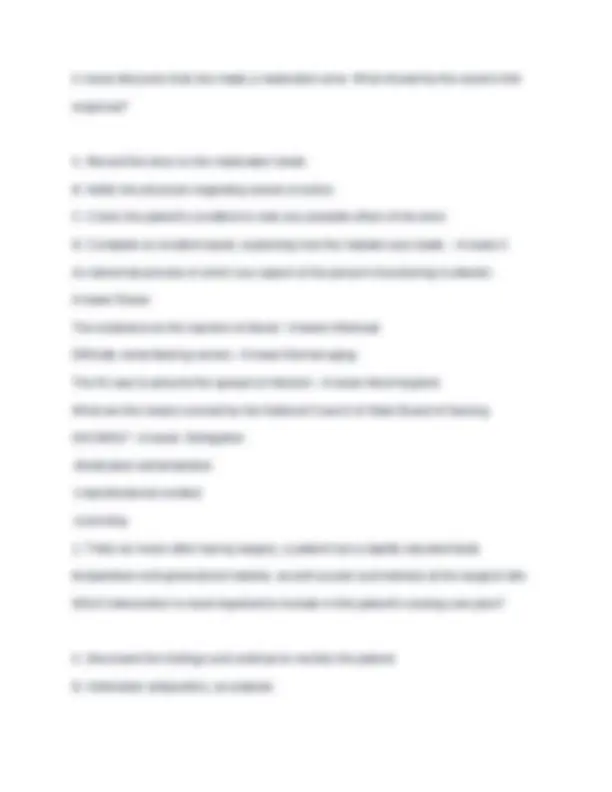
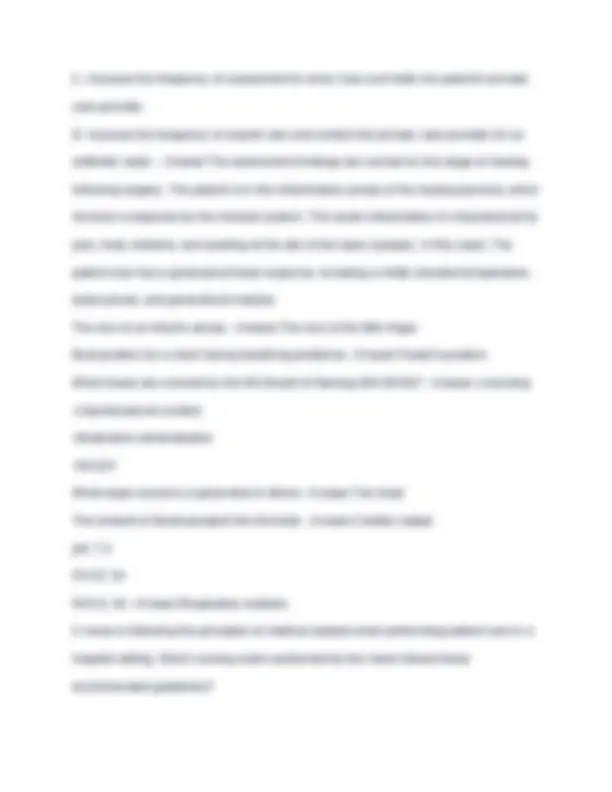
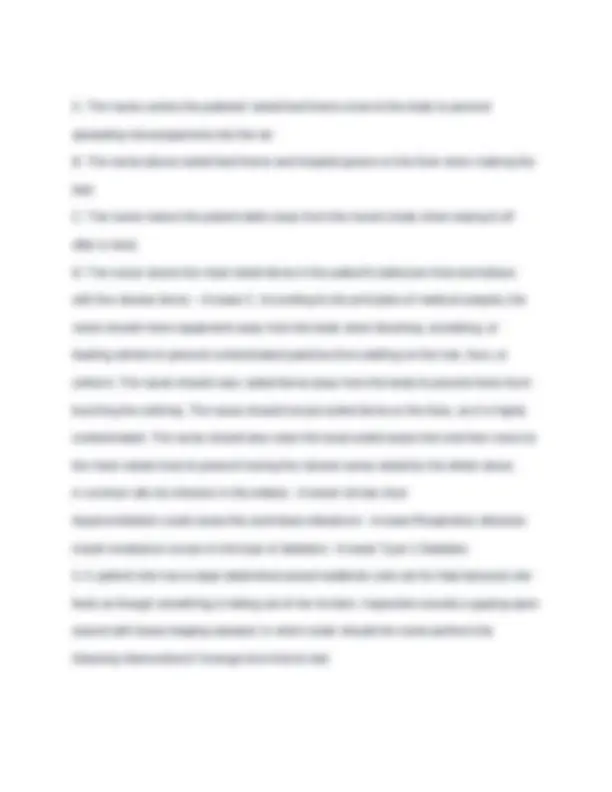
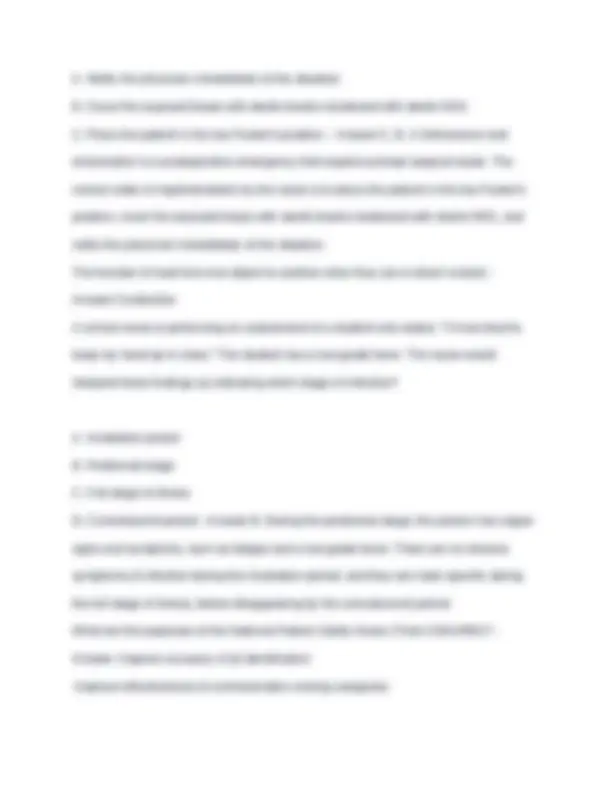
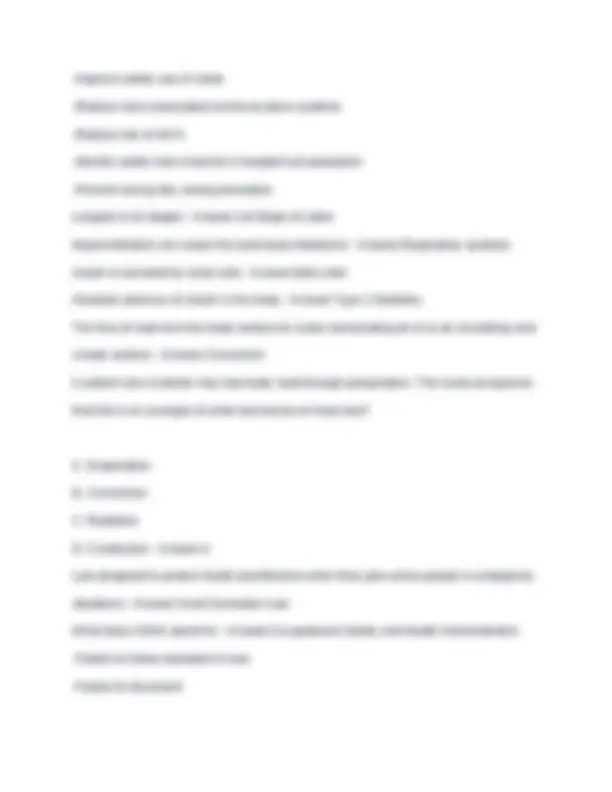
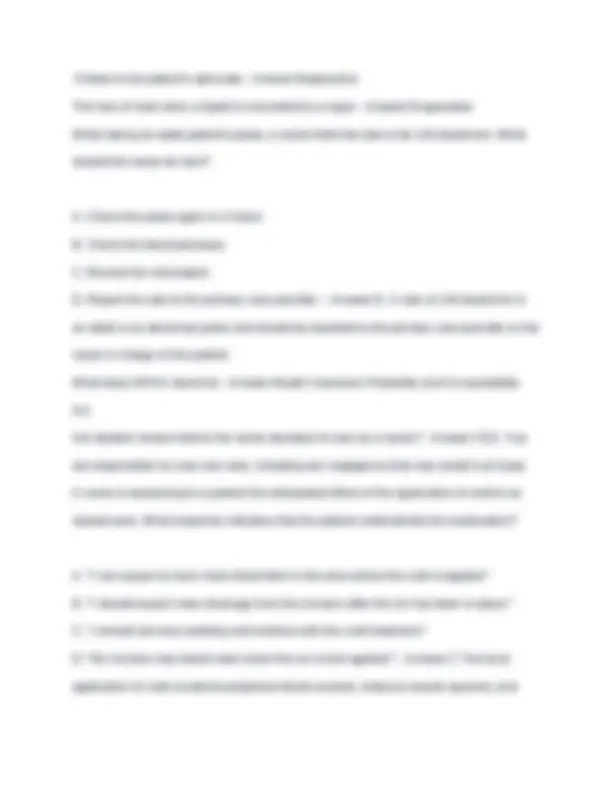
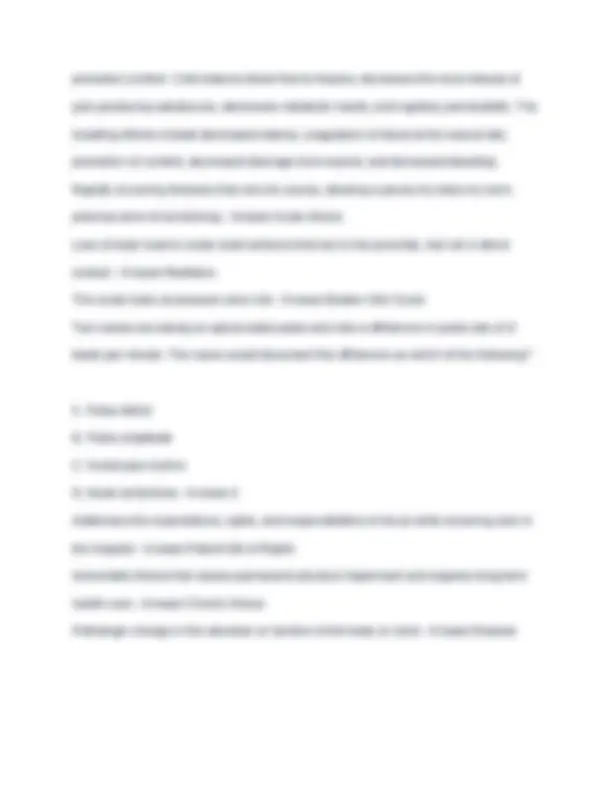
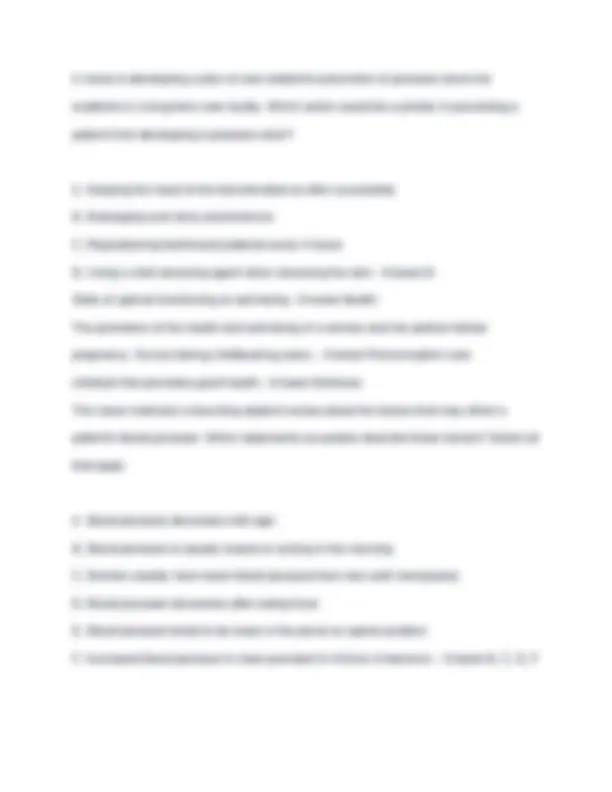
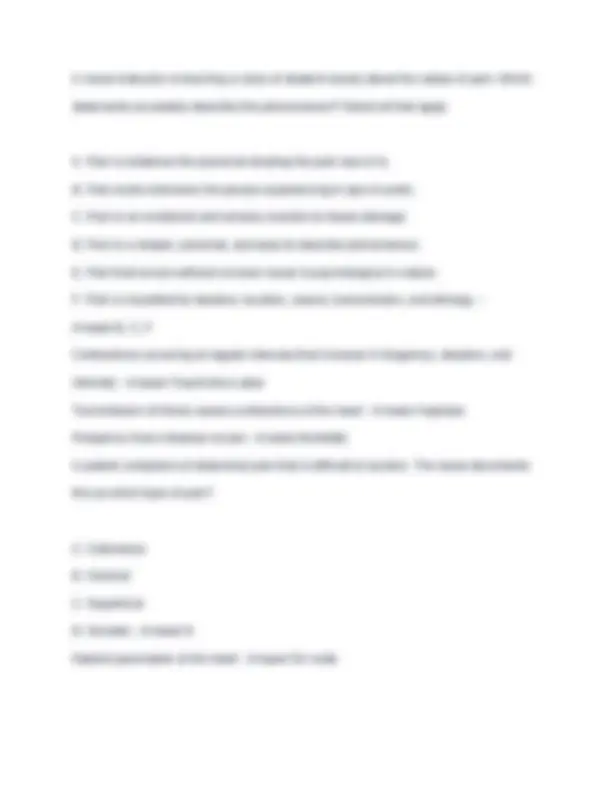
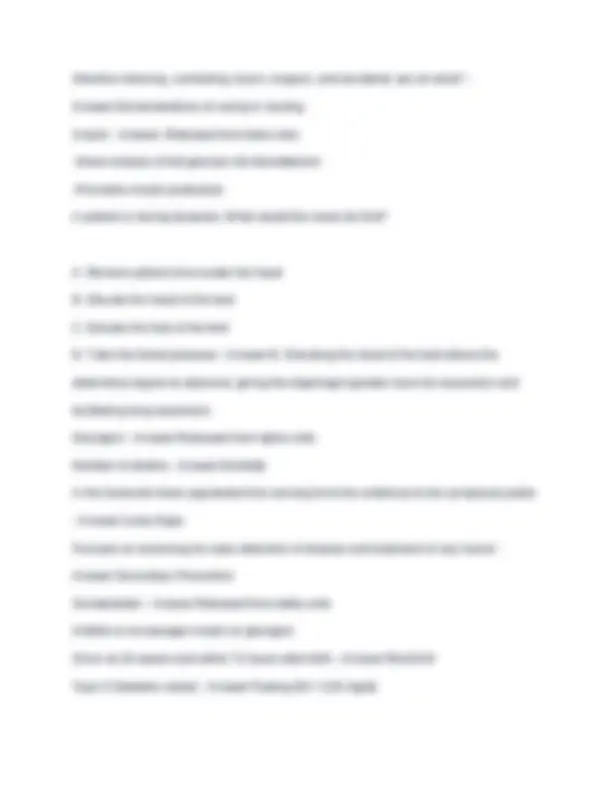
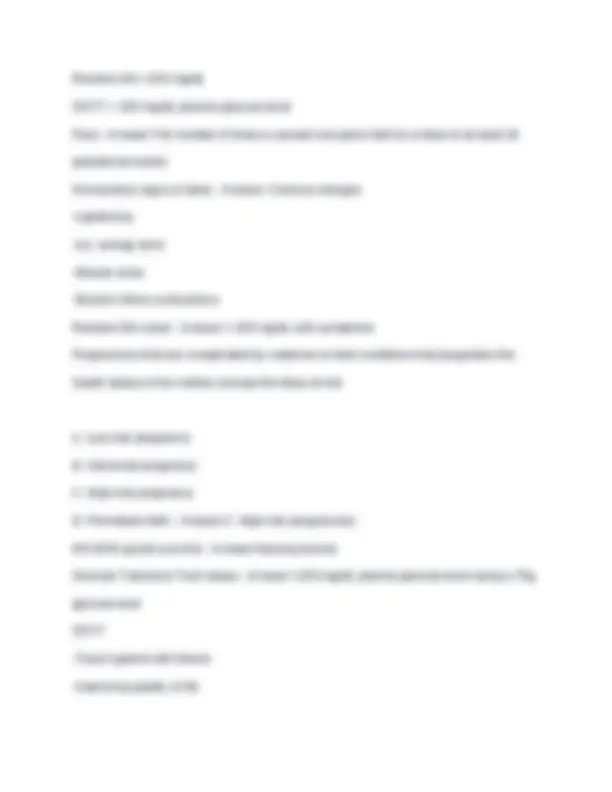
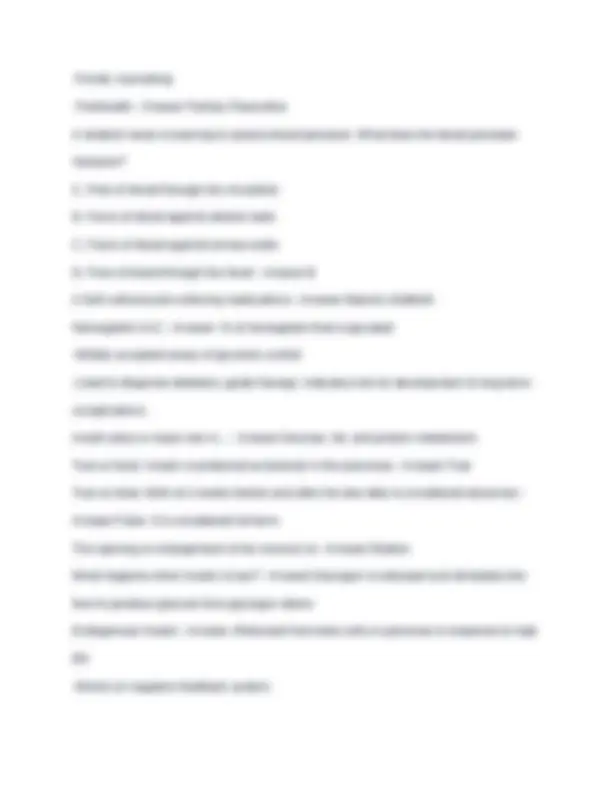
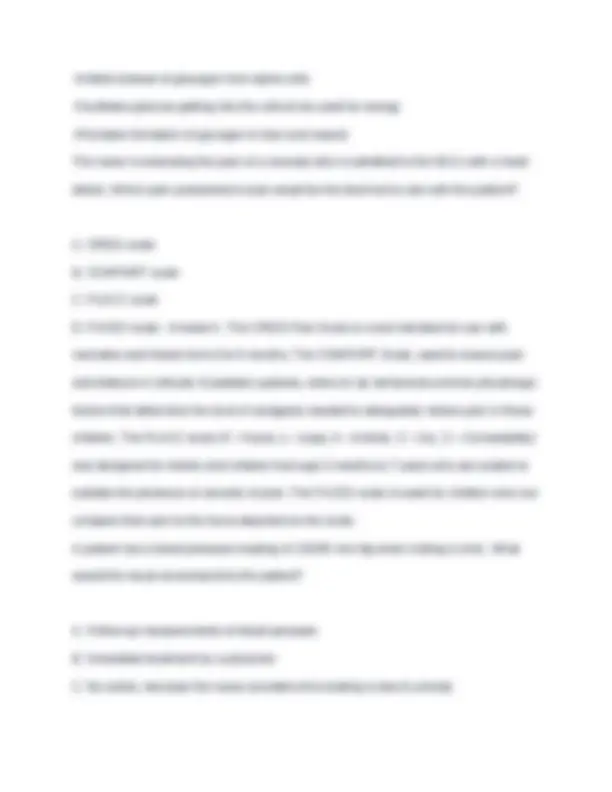
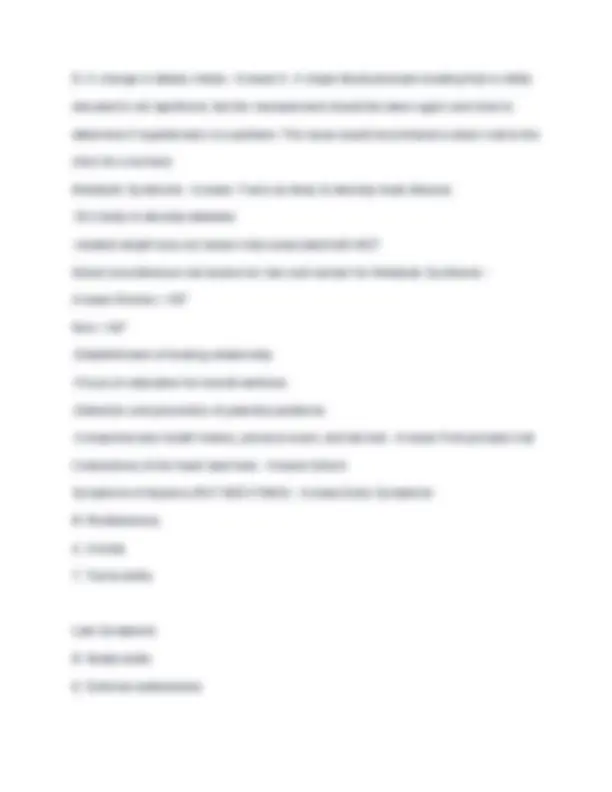
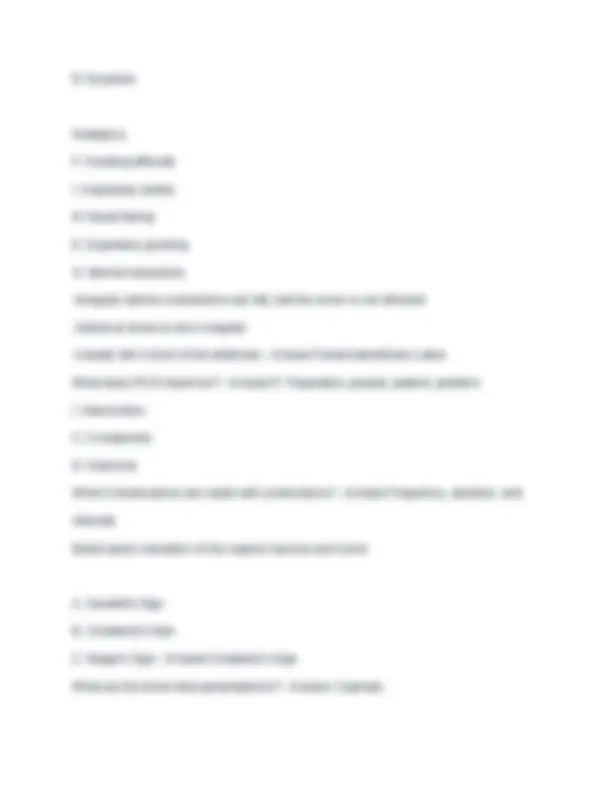
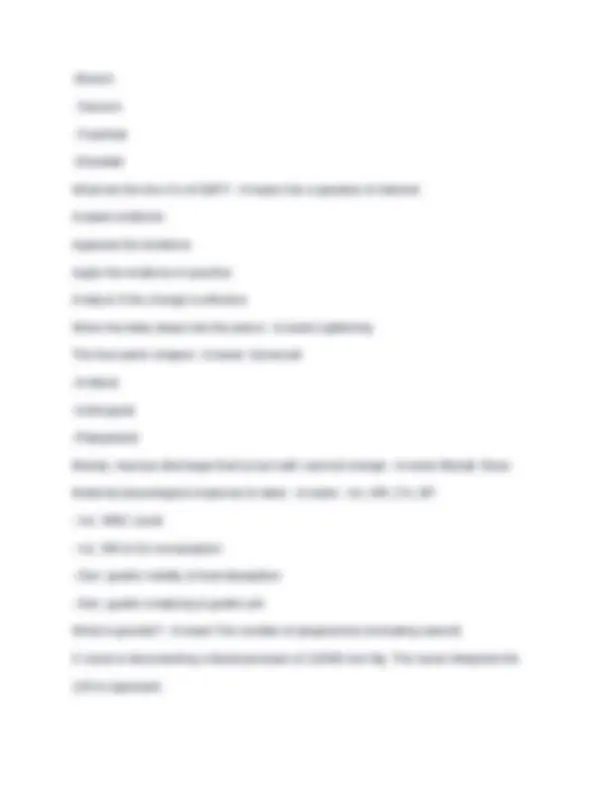
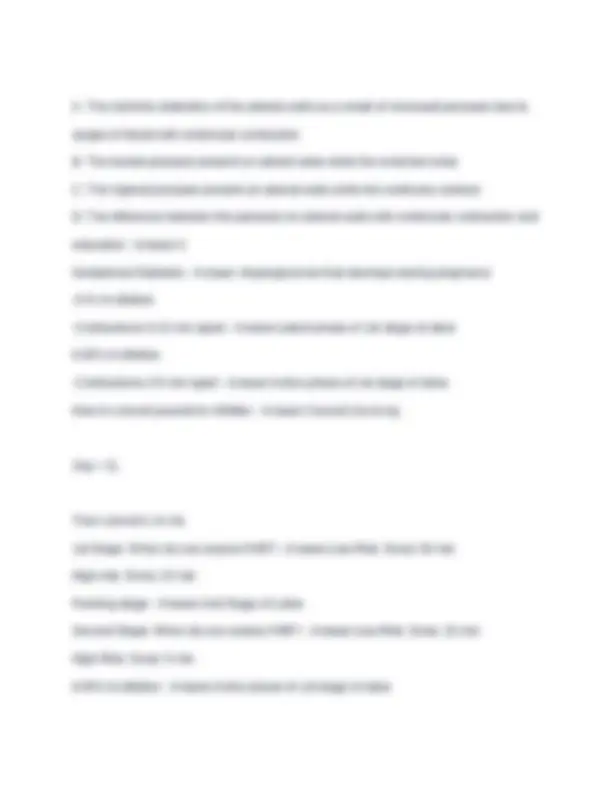
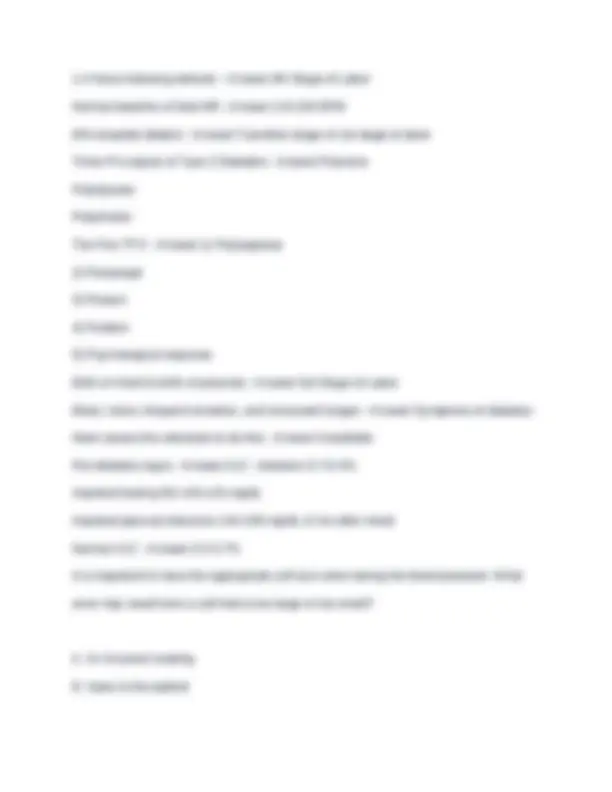
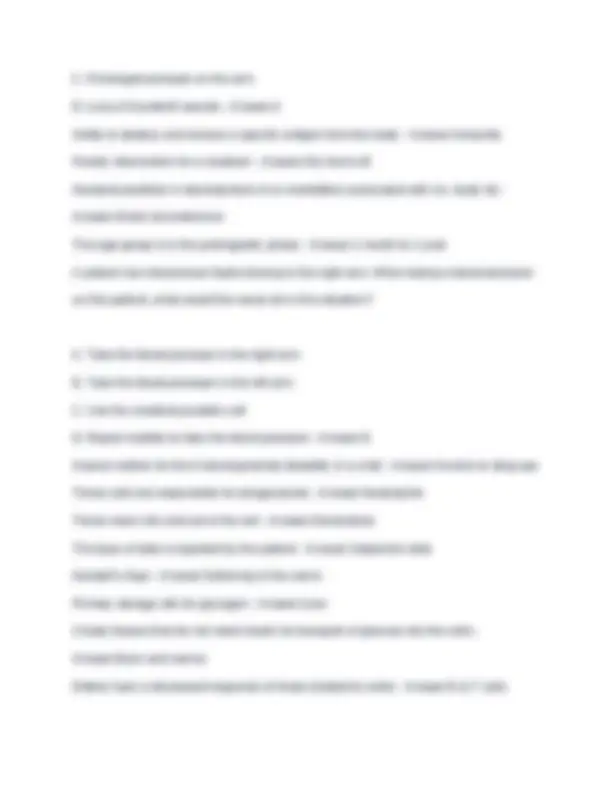
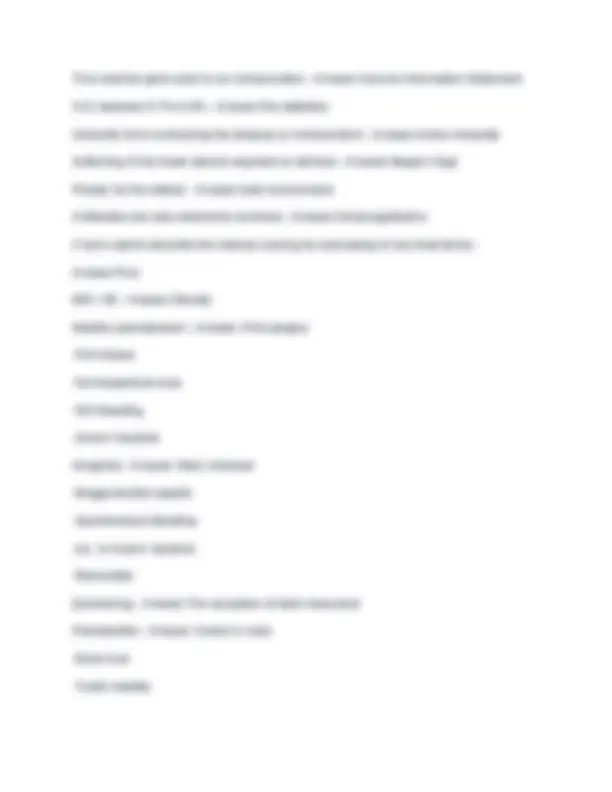
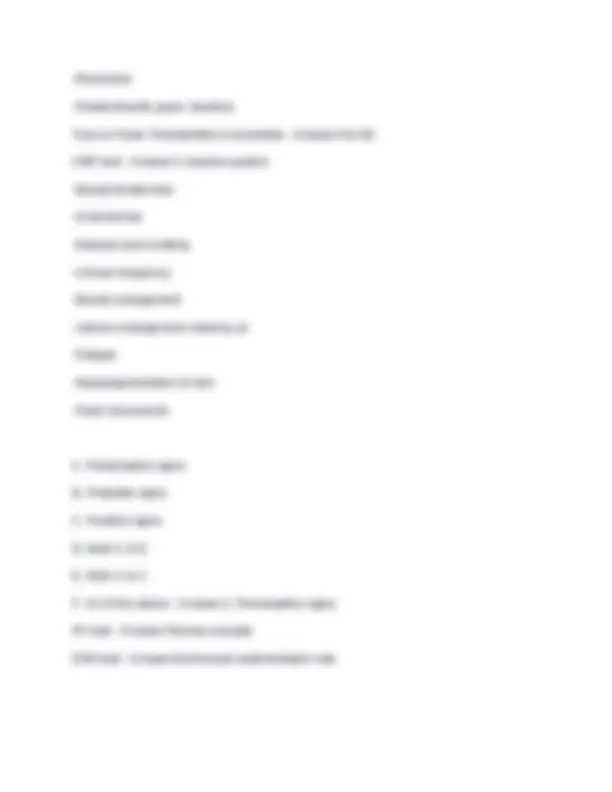
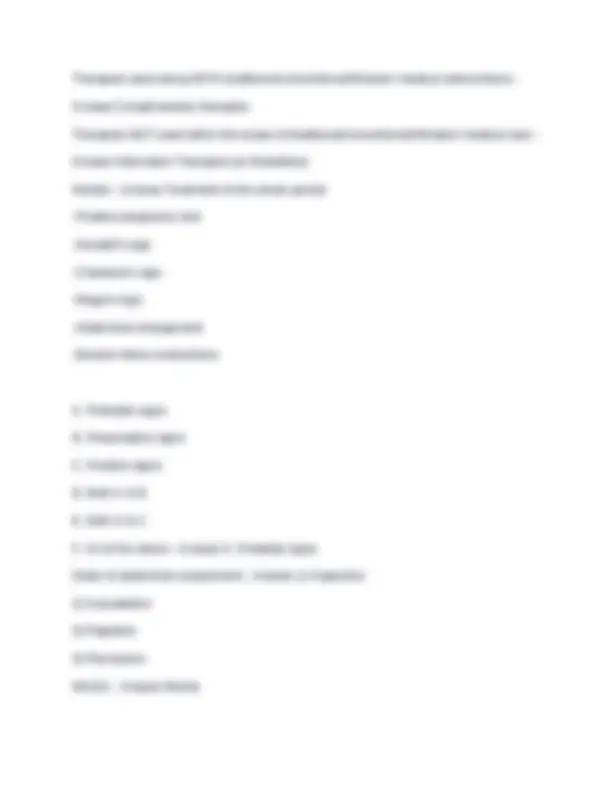
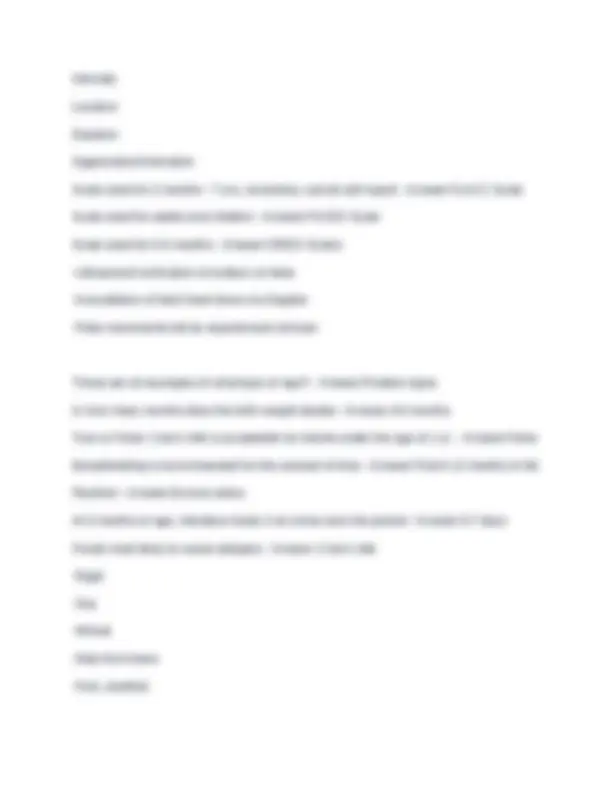
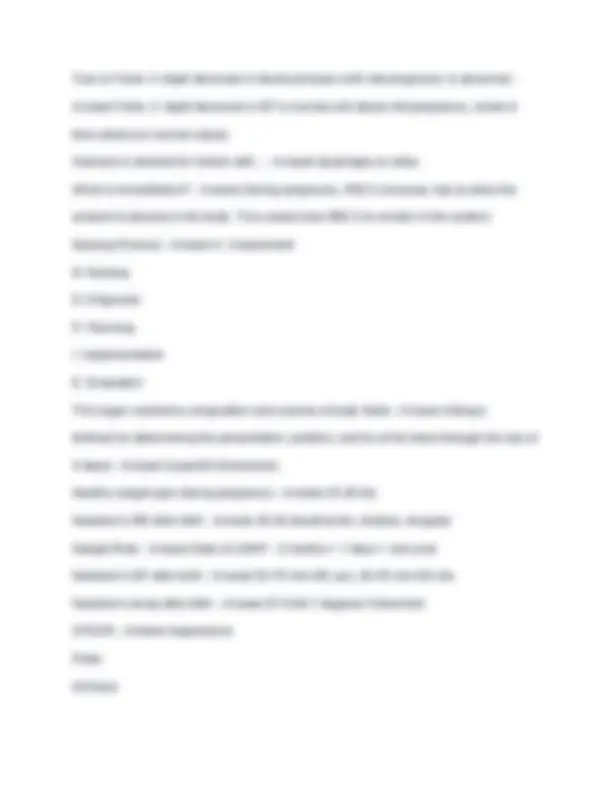
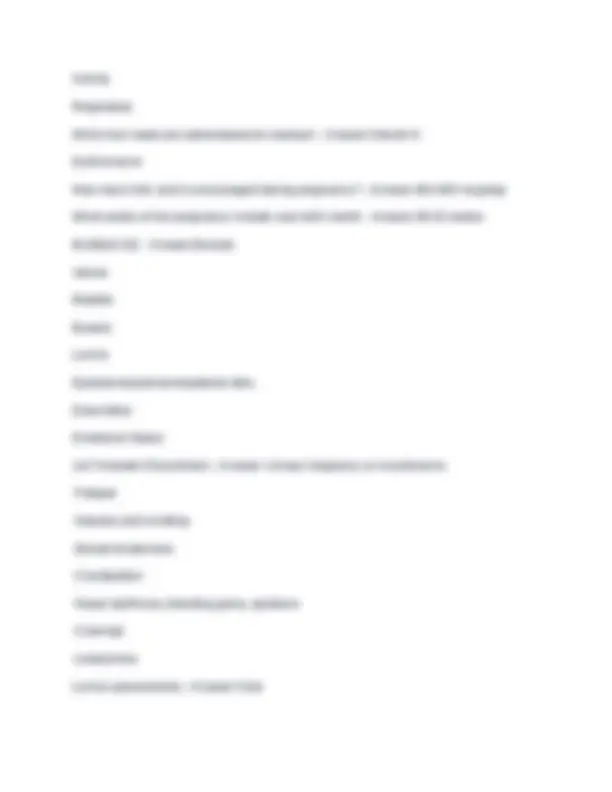
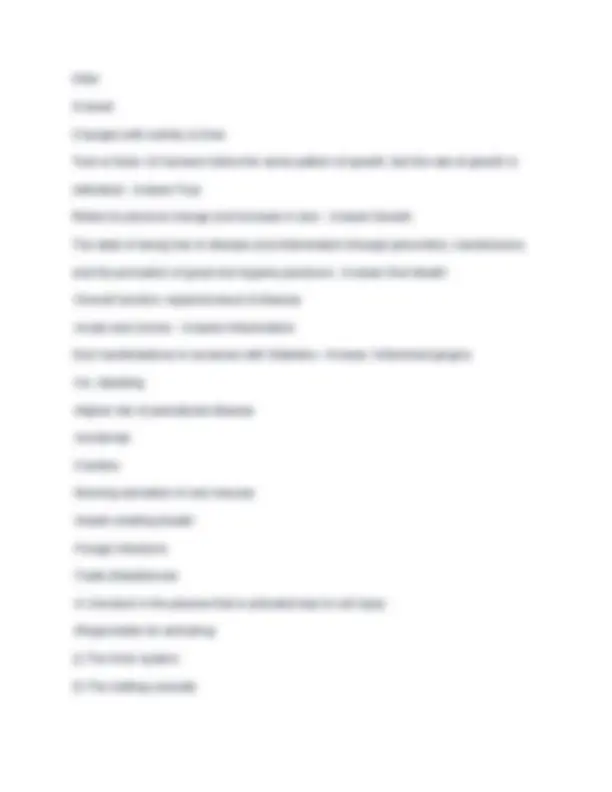
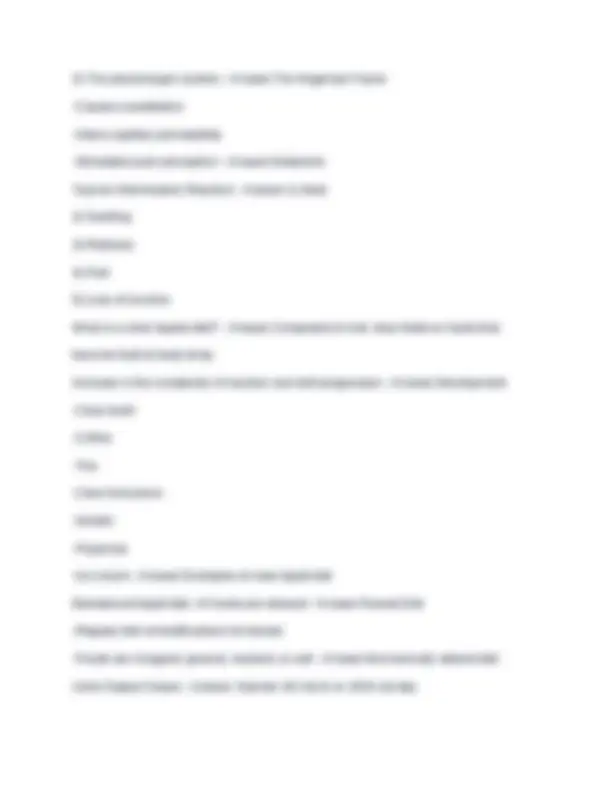
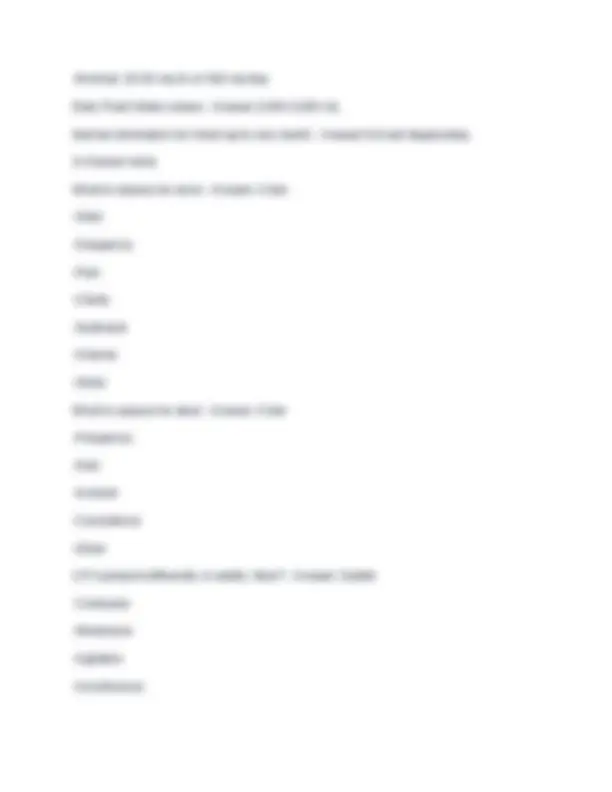
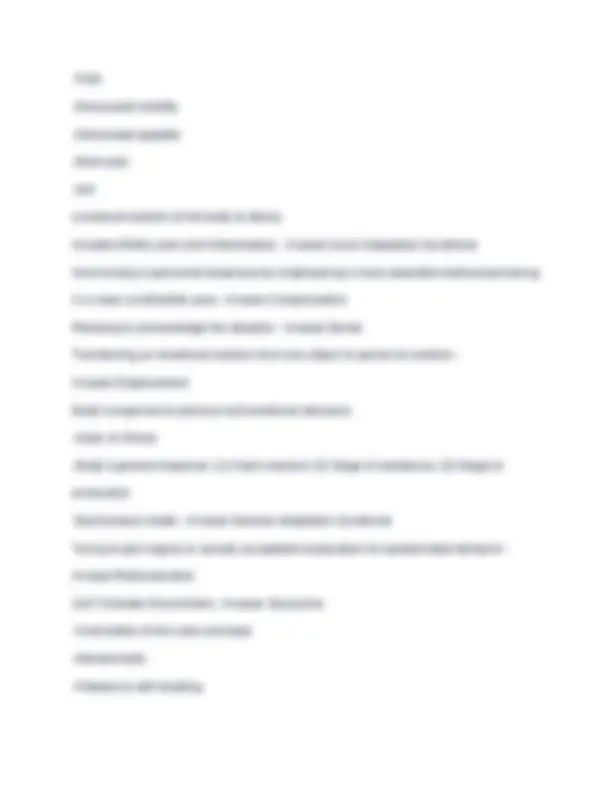
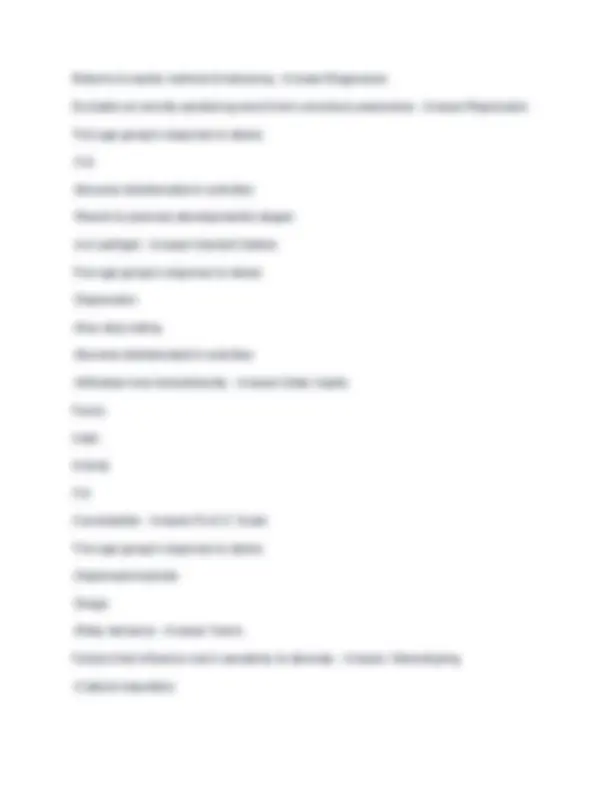
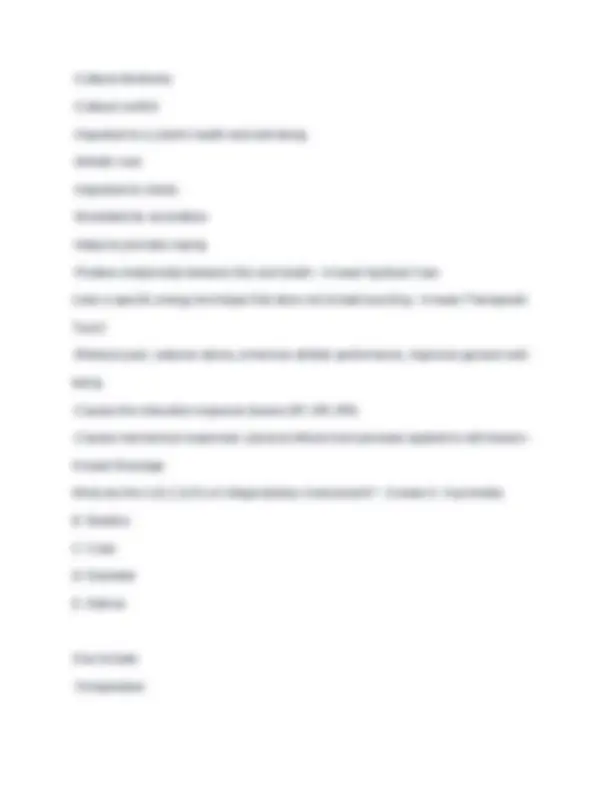
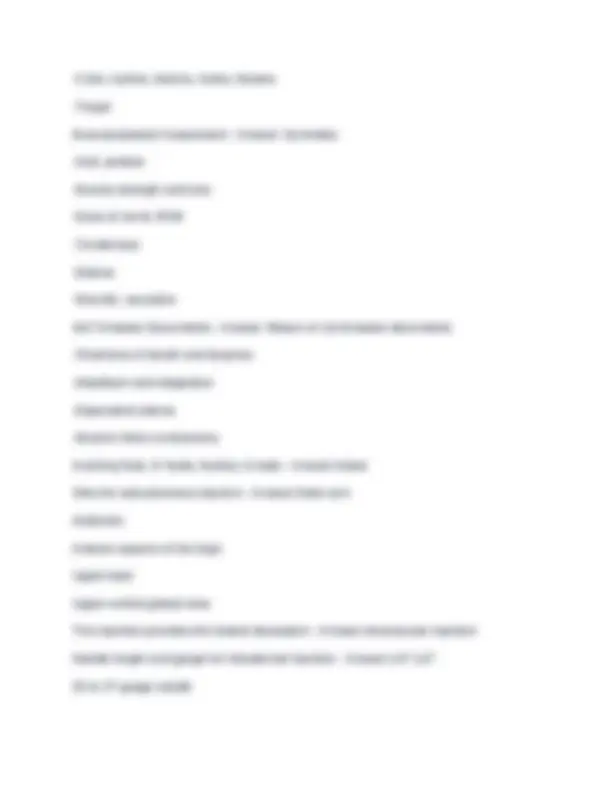

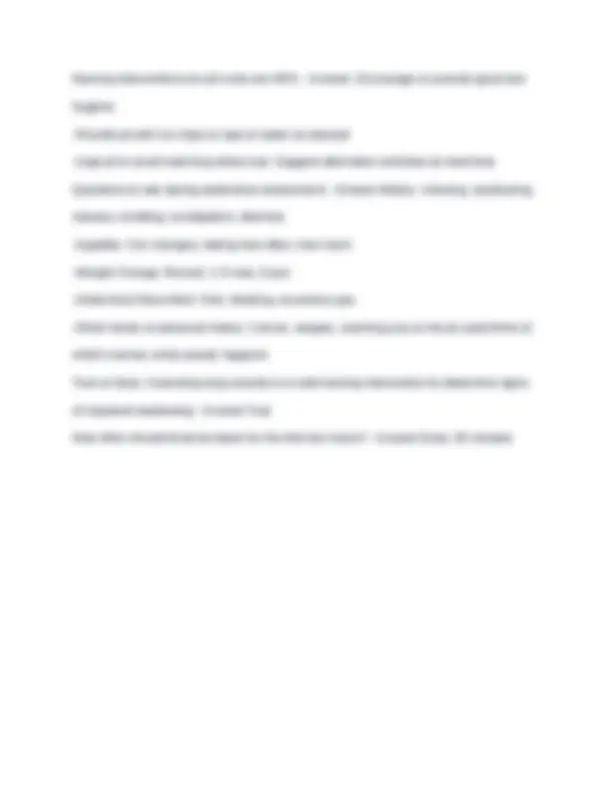


Study with the several resources on Docsity

Earn points by helping other students or get them with a premium plan


Prepare for your exams
Study with the several resources on Docsity

Earn points to download
Earn points by helping other students or get them with a premium plan
Community
Ask the community for help and clear up your study doubts
Discover the best universities in your country according to Docsity users
Free resources
Download our free guides on studying techniques, anxiety management strategies, and thesis advice from Docsity tutors
Covering various healthcare and nursing concepts, this description includes topics such as communication methods, patient conditions, illnesses, and nursing procedures. It encompasses a wide range of subjects including SBAR, postpartum diarrhea, pain reporting, hand hygiene, malpractice, pressure ulcer prevention, fetal heart rate, type 2 diabetes, newborn priority intervention, blood pressure, elderly care, substance use, and many more.
Typology: Exams
1 / 52

This page cannot be seen from the preview
Don't miss anything!













































A nurse is caring for a patient in the ICU who is being monitored for a possible cerebral aneurysm following a lost of consciousness in the emergency room. The nurse anticipates preparing the pt for ordered diagnostic tests. This nurse's knowledge of the diagnostic procedures for this condition reflects which aspect of nursing? A. The art of nursing B. The science of nursing C. The caring aspect of nursing D. The holistic approach to nursing - Answer:B. The science of nursing A nurse is formulating a clinical question in PICO format. What does the letterP represent? A. Comparison to another similar treatment B. Clearly defined, focused literature review C. Specific identification of the desired outcome D. Explicit descriptions of the population of interest - Answer:D. Explicit descriptions of the population of interest Insulin - Answer:Removes excess glucose from the blood and stores it as glycogen in the liver.
Which nurse who was influential in the development of nursing in North America is regarded as the founder of American nursing? A. Clara Barton B. Lillian Wald C. Lavina Dock D. Florence Nightingale - Answer:D. Florence Nightingale The student nurse learns that illnesses are classified as either acute or chronic. Which are examples of chronic illnesses? Select all that apply. A. Diabetes mellitus B. Bronchial pneumonia C. Rheumatoid arthritis D. Cystic fibrosis E. Fractured hip F. Otitis media - Answer:A, C, & D World War II had a tremendous effect on the nursing profession. Which development occurred during this period? A. The role of the nurse was broadened B. There was a decreased emphasis on education C. Nursing was practiced mainly in hospital settings
A. Health and illness are the same for all people. B. Health and illness are individually defined by each person. C. People with acute illnesses are actually healthy. D. People with chronic illnesses have poor health beliefs. E. Health is more than the absence of illness. F. Illness is the response of a person to a disease. - Answer:B, E, & F Method of communication between health care providers about patients (the handoff) - Answer:SBAR When the newborn's head is turned to one side, the arm on that side is extended out - Answer:Tonic neck True or false: Diarrhea is a common concern postpartum - Answer:False. Constipation is a common concern if iron is administered This is the angle for a subcutaneous injection - Answer:45 degrees A nurse has volunteered to give influenza immunizations at a local clinic. What level of care is the nurse demonstrating? A. Tertiary B. Secondary C. Primary D. Promotive - Answer:C. Primary The outer most layer of the skin - Answer:Epidermis First step in the abdominal assessment - Answer:Inspection Obesity BMI - Answer:>30 mg/dL
When the bottom of the foot is stroked upwards, the newborn's toes flare out - Answer:Babinski Health promotion activities may occur on a primary, secondary, or tertiary level. Which activities are considered tertiary health promotion? Select all that apply. A. A nurse runs an immunization clinic in the inner city. B. A nurse teaches a patient with an amputation how to care for the residual limb. C. A nurse provides range-of-motion exercises for a paralyzed patient. D. A nurse teaches parents of toddlers how to childproof their homes. E. A school nurse provides screening for scoliosis for the students. F. A nurse teaches new parents how to choose and use an infant car seat. - Answer:B & C When does menstruation return after birth for non lactating women? - Answer:7- weeks Nursing students should not drink this when stressed - Answer:Alcohol A nurse administers a dose of an oral medication for hypertension to a patient who immediately vomits after swallowing the pill. What would be the appropriate initial action of the nurse in this situation? A. Readminister the medication and notify the primary care provider. B. Readminister the pill in a liquid form if possible. C. Assess the vomit, looking for the pill.
C. "What types of food do you eat for meals?" D. "Why can't you just eat our food while you are here?" - Answer:C Which acid-base imbalance would the nurse suspect after assessing the following arterial blood gas values: pH, 7.30; PaCO2, 36 mm Hg; HCO3−, 14 mEq/L? A. Respiratory acidosis B. Respiratory alkalosis C. Metabolic acidosis D. Metabolic alkalosis - Answer:C When either the palm of the hand or the ball of the foot is touched, the digits wrap around the object - Answer:Grasp pH normal values - Answer:7.35-7. A nurse is administering an oral medication to a patient via a gastric tube. The nurse observes the medication enter the tube, and then the tube becomes clogged. What would be the appropriate initial action of the nurse in this situation? A. Attempt to dislodge the medication with a 10-mL syringe. B. Notify the primary care provider. C. Remove the tube and replace it with another tube. D. Flush the tube with 60 mL of water. - Answer:A. If medication becomes clogged in a gastric tube, the nurse should attach a 10-mL syringe on the end of the tube and pull back and lightly apply pressure to the plunger in a repetitive motion to attempt to
dislodge the medication. If the medication does not move through the tube, the nurse should notify the primary care provider, who may request the tube be replaced. HCO3 normal values - Answer:22-26 mEq/L When does menstruation return for lactating women? - Answer:It's dependent on breast feeding frequency and duration. Anywhere from 2-18 months. A nurse is teaching a novice nurse how to provide culturally competent care to patients in a culturally diverse community health clinic. Although all of the following are important to providing culturally competent nursing care, which one is most basic? A. Learning the predominant language of the community B. Obtaining significant information about the community C. Treating each patient at the clinic as an individual D. Recognizing the importance of the patient's family - Answer:C A nurse witnesses a street robbery and is assessing a 26-year-old female patient who is the victim. The patient has minor scrapes and bruises and tells the nurse, "I've never been so scared in my life." What other symptoms would the nurse expect to find related to the fight-or-flight response to stress? Select all that apply. A. Increased heart rate B. Decreased muscle strength C. Increased mental alertness D. Increased blood glucose levels E. Decreased cardiac output
-Medications -Hypovolemia/dehydration -Stress -Position Normal total serum Calcium level - Answer:8.6-10.2 mg/dL A medication order reads: "K-Dur, 20 mEq po b.i.d." When and how does the nurse correctly give this drug? A. Daily at bedtime by subcutaneous route B. Every other day by mouth C. Twice a day by the oral route D. Once a week by transdermal patch - Answer:C Questions to ask before taking temperature - Answer:-Food -Beverages -Gum -Drinking/Smoking Magnesium normal values - Answer:1.3-2.3 mEq/L A nurse is interviewing a patient who just received news that he has pancreatic cancer. The patient tells the nurse that getting cancer could never happen to him. Which defense mechanism is this patient demonstrating? A. Projection B. Denial
C. Displacement D. Repression - Answer:B A patient's health history of breast cancer that runs in the family is what type of risk factor? - Answer:Non-modifiable risk factor Laws affecting nursing practice (Think PHMPG) - Answer:-Right of Privacy -HIPAA -Malpractice -Patient's Bill of Rights -Good Samaritan Law Rubra - Answer:Deep red mixture, first 3-4 days A nurse administers the wrong medication to a patient and the patient is harmed. The physician who ordered the medication did not read the documentation that the patient was allergic to the drug. Which statement is true regarding liability for the administration of the wrong medication? A. The nurse is not responsible, because the nurse was merely following the doctor's orders. B. Only the nurse is responsible, because the nurse actually administered the medication. C. Only the physician is responsible, because the physician actually ordered the drug. D. Both the nurse and the physician are responsible for their respective actions. - Answer:D. Nurses are legally responsible for carrying out the orders of the physician in charge of a patient unless an order would lead a reasonable person to anticipate injury
D. The nurse identifies several options for intervening in the patient's care and critiques the merit of each option. - Answer:C. The first step when thinking critically about a situation is to identify the purpose or goal of your thinking. Reassessing the patient helps to discipline thinking by directing all thoughts toward the goal. Once the problem is addressed, it is important for the nurse to judge the adequacy of the knowledge, identify potential problems, use helpful resources, and critique the decision. Serosa - Answer:2nd stage, pinkish-brownish discharge, expelled 3-10 days. Drugs used to open airways - Answer:Bronchodilators PCO2 normal values - Answer:35-45 mm Hg A nurse is administering a pain medication to a patient. In addition to checking his identification bracelet, the nurse correctly verifies his identity by: A. Asking the patient his name B. Reading the patient's name on the sign over the bed C. Asking the patient's roommate to verify his name D. Asking, "Are you Mr. Brown?" - Answer:A PO2 normal values - Answer:80-100 mm Hg Prenatal vitamins, immunizations, providing education on health habits - Answer:Primary prevention A nurse is assessing a 15-year-old female patient who is diagnosed with anorexia. Following the assessment, the nurse recommends that the patient meet with a nutritionist. This action best exemplifies the use of:
A. Clinical judgment B. Clinical reasoning C. Critical thinking D. Blended competencies - Answer:A What are verbal, nonverbal, written, and electronic? - Answer:Types of communication Bradykinin - Answer:-Causes loval vasodilation -Stimulates nerve endings to cause pain -Causes the release of arachidonic acid from cell membrane This is what the body does in response to stressors - Answer:Adapt This organ needs 25% of our bld supply and is affected with a decrease in perfusion - Answer:Kidneys A medication order reads: "Hydromorphone, 2 mg IV every 3 to 4 hours PRN pain." The prefilled cartridge is available with a label reading "Hydromorphone 2 mg/1 mL." The cartridge contains 1.2 mL of hydromorphone. Which nursing action is correct? A. Give all the medication in the cartridge because it expanded when it was mixed. B. Call the pharmacy and request the proper dose. C. Refuse to give the medication. D. Dispose of 0.2 mL correctly before administering the drug. - Answer:D. Many cartridges are overfilled, and some of the medication needs to be discarded. Always check the volume needed to provide the correct dose with the volume in the syringe. Giving the excess medication in the cartridge may result in adverse effects for the
B. Inject air into the NPH insulin vial, being careful not to allow the solution to touch the needle; next, inject air into the regular insulin vial and withdraw 10 units; then, withdraw 40 units of NPH insulin. C. Inject air into the regular insulin vial, being careful not to allow the solution to touch the needle; next, inject air into the NPH insulin vial and withdraw 40 units; then, withdraw 10 units of regular insulin. D. Inject air into the NPH insulin vial and withdraw 40 units; then, using the same syringe, inject air into the regular insulin vial and withdraw 10 units of regular insulin. - Answer:B Regular or short-acting insulin should never be contaminated with NPH or any insulin modified with added protein. Placing air in the NPH vial first without allowing the needle to contact the solution ensures that the regular insulin will not be contaminated. The primary source of heat in the body - Answer:Metabolism When a nurse enters the patient's room to begin a nursing history, the patient's wife is there. What should the nurse do? A. Introduce oneself and thank the wife for being present. B. Introduce oneself and ask the wife if she wants to remain. C. Introduce oneself and ask the wife to leave. D. Introduce oneself and ask the patient if he would like the wife to stay. - Answer:D The best person to report pain - Answer:The person having the pain A nurse can be negligent if they fail to follow these - Answer:Standards of practice Alba - Answer:Final stage, occurs 10-14 days, but can last 3-6 weeks postpartum
A nurse is administering heparin subcutaneously to a patient. What is the correct technique for this procedure? A. Aspirate before giving and gently massage after the injection. B. Do not aspirate; massage the site for 1 minute. C. Do not aspirate before or massage after the injection. D. Massage the site of the injection; aspiration is not necessary but will do no harm. - Answer:C. When giving heparin subcutaneously, the nurse should not aspirate or massage, so as not to cause trauma or bleeding in the tissues. pH: 72. PCO2: 24 HCO3: 16 - Answer:Metabolic acidosis The nurse is surprised to detect an elevated temperature (102°F) in a patient scheduled for surgery. The patient has been afebrile and shows no other signs of being febrile. What is the first thing the nurse should do? A. Inform the charge nurse. B. Inform the surgeon. C. Validate the finding. D. Document the finding. - Answer:C. The nurse should first validate the finding if it is unusual, deviates from normal, and is unsupported by other data. Should the initial recording prove to be in error, it would have been premature to notify the charge nurse
A nurse discovers that she made a medication error. What should be the nurse's first response? A. Record the error on the medication sheet. B. Notify the physician regarding course of action. C. Check the patient's condition to note any possible effect of the error. D. Complete an incident report, explaining how the mistake was made. - Answer:C An abnormal process in which any aspect of the person's functioning is altered - Answer:Illness The resistance to the injection of blood - Answer:Afterload Difficulty remembering names - Answer:Normal aging The #1 way to prevent the spread of infection - Answer:Hand hygiene What are the issues covered by the National Council of State Board of Nursing (NCSBN)? - Answer:-Delegation -Medication administration -Unprofessional conduct -Licensing
C. Increase the frequency of assessment to every hour and notify the patient's primary care provider. D. Increase the frequency of wound care and contact the primary care provider for an antibiotic order. - Answer:The assessment findings are normal for this stage of healing following surgery. The patient is in the inflammatory phase of the healing process, which involves a response by the immune system. This acute inflammation is characterized by pain, heat, redness, and swelling at the site of the injury (surgery, in this case). The patient also has a generalized body response, including a mildly elevated temperature, leukocytosis, and generalized malaise. The size of an infant's airway - Answer:The size of the little finger Best position for a client having breathing problems - Answer:Fowler's position What issues are covered by the MN Board of Nursing (MN BON)? - Answer:-Licensing -Unprofessional conduct -Medication administration -NCLEX What organ reacts to a great deal of stress - Answer:The heart The amount of blood pumped into the body - Answer:Cardiac output pH: 7. PCO2: 54 HCO3: 26 - Answer:Respiratory acidosis A nurse is following the principles of medical asepsis when performing patient care in a hospital setting. Which nursing action performed by the nurse follows these recommended guidelines?